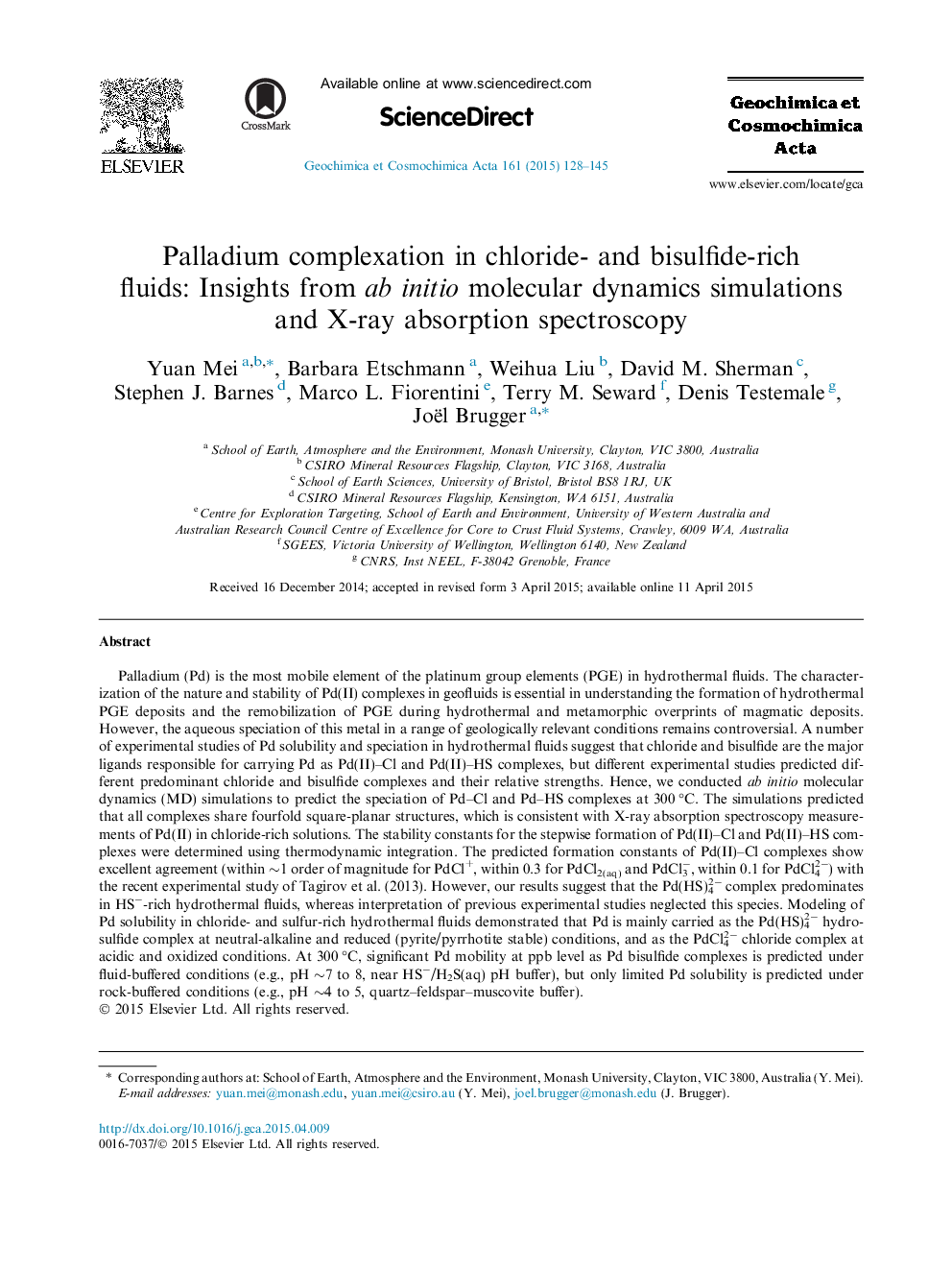| کد مقاله | کد نشریه | سال انتشار | مقاله انگلیسی | نسخه تمام متن |
|---|---|---|---|---|
| 6437992 | 1637996 | 2015 | 18 صفحه PDF | دانلود رایگان |
عنوان انگلیسی مقاله ISI
Palladium complexation in chloride- and bisulfide-rich fluids: Insights from ab initio molecular dynamics simulations and X-ray absorption spectroscopy
ترجمه فارسی عنوان
پیچیدگی پالادیوم در مایعات غنی از کلرید و بیسولفید: مشاهدات از شبیه سازی اولیه پویایی مولکولی و طیف سنجی جذب اشعه ایکس
دانلود مقاله + سفارش ترجمه
دانلود مقاله ISI انگلیسی
رایگان برای ایرانیان
موضوعات مرتبط
مهندسی و علوم پایه
علوم زمین و سیارات
ژئوشیمی و پترولوژی
چکیده انگلیسی
Palladium (Pd) is the most mobile element of the platinum group elements (PGE) in hydrothermal fluids. The characterization of the nature and stability of Pd(II) complexes in geofluids is essential in understanding the formation of hydrothermal PGE deposits and the remobilization of PGE during hydrothermal and metamorphic overprints of magmatic deposits. However, the aqueous speciation of this metal in a range of geologically relevant conditions remains controversial. A number of experimental studies of Pd solubility and speciation in hydrothermal fluids suggest that chloride and bisulfide are the major ligands responsible for carrying Pd as Pd(II)-Cl and Pd(II)-HS complexes, but different experimental studies predicted different predominant chloride and bisulfide complexes and their relative strengths. Hence, we conducted ab initio molecular dynamics (MD) simulations to predict the speciation of Pd-Cl and Pd-HS complexes at 300 °C. The simulations predicted that all complexes share fourfold square-planar structures, which is consistent with X-ray absorption spectroscopy measurements of Pd(II) in chloride-rich solutions. The stability constants for the stepwise formation of Pd(II)-Cl and Pd(II)-HS complexes were determined using thermodynamic integration. The predicted formation constants of Pd(II)-Cl complexes show excellent agreement (within â¼1 order of magnitude for PdCl+, within 0.3 for PdCl2(aq) and PdCl3â, within 0.1 for PdCl42â) with the recent experimental study of Tagirov et al. (2013). However, our results suggest that the Pd(HS)42â complex predominates in HSâ-rich hydrothermal fluids, whereas interpretation of previous experimental studies neglected this species. Modeling of Pd solubility in chloride- and sulfur-rich hydrothermal fluids demonstrated that Pd is mainly carried as the Pd(HS)42â hydrosulfide complex at neutral-alkaline and reduced (pyrite/pyrrhotite stable) conditions, and as the PdCl42â chloride complex at acidic and oxidized conditions. At 300 °C, significant Pd mobility at ppb level as Pd bisulfide complexes is predicted under fluid-buffered conditions (e.g., pH â¼7 to 8, near HSâ/H2S(aq) pH buffer), but only limited Pd solubility is predicted under rock-buffered conditions (e.g., pH â¼4 to 5, quartz-feldspar-muscovite buffer).
ناشر
Database: Elsevier - ScienceDirect (ساینس دایرکت)
Journal: Geochimica et Cosmochimica Acta - Volume 161, 15 July 2015, Pages 128-145
Journal: Geochimica et Cosmochimica Acta - Volume 161, 15 July 2015, Pages 128-145
نویسندگان
Yuan Mei, Barbara Etschmann, Weihua Liu, David M. Sherman, Stephen J. Barnes, Marco L. Fiorentini, Terry M. Seward, Denis Testemale, Joël Brugger,
